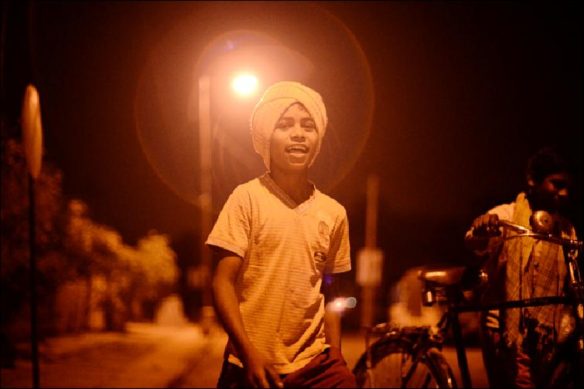CWC Newsletter – Issue 01 August 2014
Raid and Rescue: To be or not to be
Venkatesh (name changed), decided to work during his summer holidays. His widowed mother, the sole breadwinner of his large family of two sisters and a grandfather was struggling to make ends meet with her domestic labour job. Venkatesh, who would be joining class 9th the coming year and would be turning 14 shortly, felt that he had to do his bit for the family. He would at least endeavour to pay his own school fees. With the consent of his mother, he found work with a juice parlour where the owner would also provide him with lunch. Often he would have his lunch along with the owner’s family. His work was light and the resulting salary was extremely useful. On one balmy afternoon the Labour Department suddenly conducted a raid on the parlour based on an anonymous tip. Before Venkatesh could understand what was happening, he was hauled out of the shop and shut in a car by a strict looking government official who would give him no explanation but asked him a lot of questions. The parlour owner called his aunt who quickly brought his education related papers to prove that he was studying. This was to no avail. She was rudely asked, if she could prove she was his aunt and then Venkatesh was carried away and institutionalized within the Juvenile Justice system.
It took heavy advocacy to pull Venkatesh out of the institution. His distraught mother asked the media why the government, which never showed up to support her through her poverty, was now bent on making her and her sons life worse by traumatizing them through such a harrowing ironically termed ‘rescue’.
The ban approach to child labour, in its actual field enactment implies that children such as Venkatesh, who are embedded in the larger social reality of a country where poverty is widespread, are often at the receiving end of ‘rescues’ which instead of protecting their rights, often tend to violate them. ‘Rescues’ involve children being caught by inspectors, dragged out of their work spaces, pulled into vehicles, deposited in alien institutions without an explanation under heavy adult scrutiny. The result for the child is a sense of being ‘criminalised’ even as their parents/guardians are actually treated as ‘offenders’.
Over the last few years, in conversation with children, we have arrived at the following clarity and understanding regarding the ‘raid and rescue’ method used across various types of work. The children’s experience can be categorised into three broad sections: as working children involved in legally permitted work that contributes to their growth and development such as an apprenticeship under adult supervision; children engaged in non-hazardous work in unfriendly conditions such as long hours with no breaks for otherwise light work; children involved in hazardous work. As in the case described above, the actual experience of the ‘raid and rescue’ was traumatic through all three situations.
In the case of children involved in non-harmful work, the raids were unlawful and arbitrary whereas in the case of the other two, the current process was highly faulty leading to increased trauma with no provisioning of long term solutions for the child in a difficult situation. This has meant that children have found it difficult then to contribute at home and the loss of household income often results in the child leaving school, being pushed into more dangerous work away from the public eye, malnourishment, etc. The trauma and shame experienced due to inept handling by unskilled and untrained staff only adds to the alienation experienced by the children and their family.
Such a scenario, after 25 years of India being a signatory of the UN Convention on the Rights of the Child (CRC), implies that a serious re-evaluation of our collective effort to support working children needs to take place. The current law on child labour responds only in a narrow punitive manner to the demand side of child labour. It refuses to acknowledge the supply side.
If we are to keep children at the centre of our approach to the issue, then asking and addressing why children work is fundamental. What an engagement with this question does, is flip the debate and build it on the terms of the child engaged in work. It brings the voice of children into the fold of governance. It asks for spaces where children may raise their voices without the expectation of sudden repercussions. It asks for research which builds on their experience. It recognizes the ‘child’ not as a passive recipient of the State’s parental protection but as an active citizen who has knowledge of her/his circumstances and can apply it to their life constructively. Also, it importantly implies that a holistic approach which considers the entire cycle of vulnerability from preventive measures to provisioning long term alternative options come within the purview of the response to child labour.
The Concerned for Working Children has supported the formation of working children’s union, Bhima Sangha, in India since the 1990s. Bhima Sangha, along with the other International Children’s Movements, chose 30th April as a celebration of child workers. The first step they felt was to emerge from the fold of invisibility and assert their existence. Since then they have engaged through a multitude of creative ways on international, national and local forums to highlight their issues and bring out unique solutions.
We call for a deeper reflection on all parameters of child labour. We ask to move beyond the language and methodology of the ban and join the children in a conversation, a dialogue. Let us open spaces, so we begin to see and experience the world from their perspective.
CWC joins the committee reviewing the Panchayat Raj Act in Karnataka
A Committee has been set up by the Government of Karnataka for the purpose of recommending amendments to the Karnataka Panchayati Raj Act, 1993 under the chairmanship of Shri. K. R. Ramesh. Nandana Reddy, the Convenor of the Gram Panchayat Hakkottaya Andolana (GPHA) and Director, Development, The Concerned for Working Children, is one of the 21 members who are part of this Committee. The review is being undertaken as an introspection on the implementation of the Act currently. The task of the Committee is to examine whether the concept of Gram Swaraj as envisaged by Mahatma Gandhi and the intention of Shri. Rajiv Gandhi to transform the Panchayati Raj system in India as a unit of self governance ensuring the democratic participation of women, the backward and the depressed in the administration of local governance, are adequately realized in the letter and in practice.
In particular, the Committee, is looking at the devolution of the 3Fs (funds, functions and functionaries) and the maximum extent of ‘endowment’ necessary for the Panchayats to govern and manage all development schemes and the machinery for economic and social justice. It is also giving special emphasis on operationalising the 50% reservation of women beyond the law by provisioning them with support structures which not only augment their knowledge and skills but also allow for their greater, more involved participation. The Committee has suggested the process of Activity Mapping to ensure that parallel structures of governance are recognized and all connected laws and institutional mechanisms are harmonised with the arrangements that strengthen the Panchayats as envisaged in the Constitution.
The Committee has undertaken a wide number of consultations in the state of Karnataka. There were four regional consultations at Mysore, Bangalore, Belgaum and Gulbarga, each attended by more than 200 people. Added to these, consultations were undertaken with: representatives from different political parties; local self government representatives in the upper house; members of the Karnataka State Panchayat Parishad; NGOs and experts on local self government; senior bureaucrats of the administration. While Nandana has participated as a member of the Committee, members of the GPHA have participated extensively across the regional meetings as audience and shared their thoughts on required changes to the law.
Through 24th to 20th June 2014, the entire Committee and some special invitees met at the Ecumenical Christian Centre, Bangalore to discuss the outcomes of the various meetings and to put together the language of the entire Bill. The Bill will most probably be tabled in the upcoming session of the Assembly. If passed, it will be one of the most progressive PRI related law in the country.
Click on the link to read more about Gram Panchayat Hakkottaya Andolana (GPHA) .
Links to related news:
- 10 December 2013, Panel to study relevance of Panchayat Raj Act, The Hindu
- 4 June 2014, Report on amendments to panchayat raj Act to be submitted by June 23, The Hindu
- 4 June 2014, Panel to Recommend KPSC-like Body for Panchayat Recruitments, The New Indian Express
- 16 June 2014, ‘Draft of Amendment to Panchayat Raj Act by Oct’, The New Indian Express






